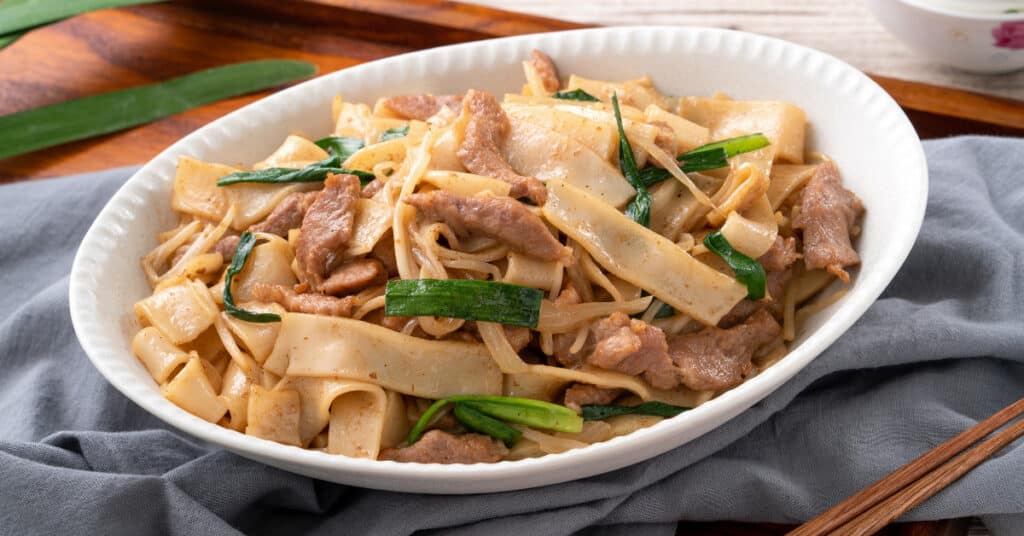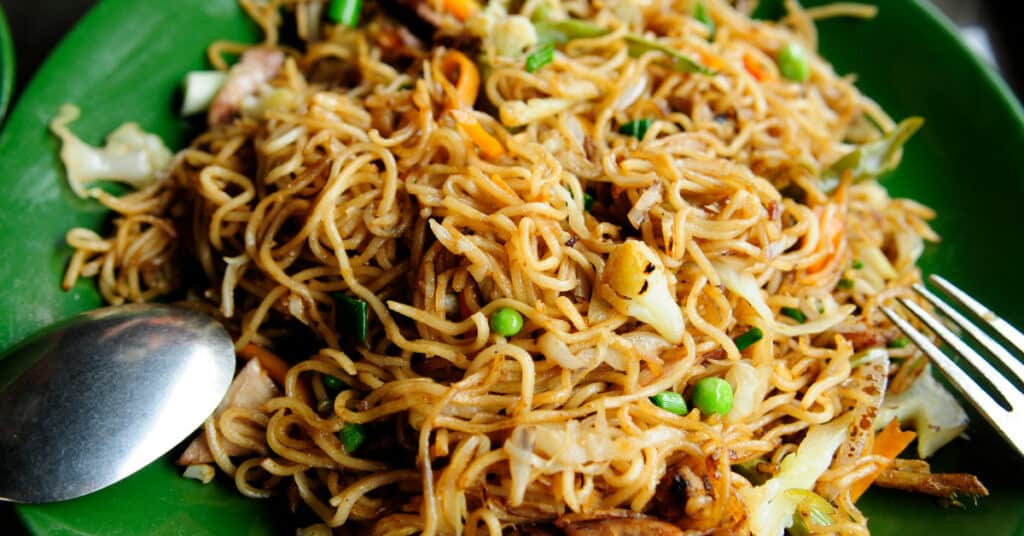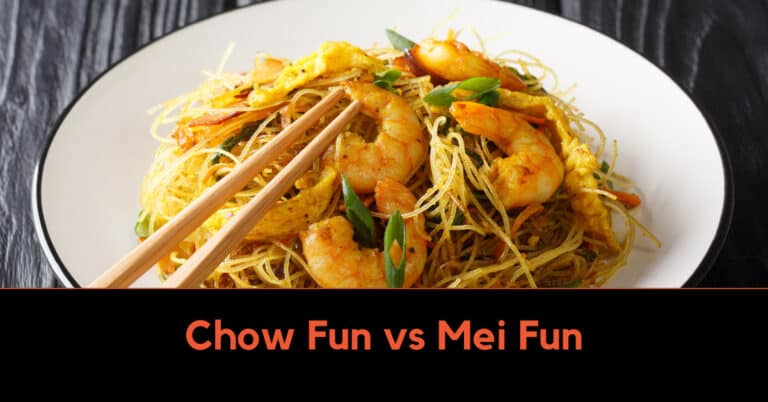SUMMARY: Chow fun and mei fun are two popular Chinese noodle dishes that often need clarification due to their similar appearance. Chow fun is made with wide rice noodles, while mei fun is made with thin rice noodles, resulting in different textures and flavors in the final dish.
When ordering Chinese noodles, do you need clarification about the difference between chow fun and mei fun?
If so, you’re not alone! This informative article will delve into chow fun and mei fun, exploring their unique characteristics and helping you understand the differences. Get ready to tantalize your taste buds and satisfy your curiosity as we cover the following subtopics:
- Definition and origin of chow fun and mei fun
- Key ingredients used in each dish
- Regional variations and unique flavors
- Cooking techniques and texture differences
So sit tight, grab a cup of tea, and embark on a delicious journey to unravel the mysteries of chow fun and mei fun!
Chow Fun – The Wider and Flatter Option
Chow fun, or stir-fried hor fun, is a delectable Chinese noodle dish from Guangdong province. It is characterized by broad, flat rice noodles with a satisfying, chewy texture. Here’s everything you need to know about this delightful dish:
Origin and Definition
Chow fun traces its roots back to the Pearl River Delta region in southern China, where it is a staple in Cantonese cuisine. “chow fun” literally translates to “stir-fried rice noodles” in Cantonese.
Ingredients
- Rice noodles: Chow fun is all about the wide, flat rice noodles, which are the dish’s star ingredient. These noodles are typically made from rice flour and water, resulting in a soft and chewy texture.
- Meat or seafood: Chow fun is often prepared with various protein options. The most popular choices include beef, shrimp, chicken, and squid.
- Vegetables: Along with the protein, chow fun is usually stir-fried with fresh vegetables. Common additions include Chinese broccoli, bean sprouts, and scallions.
- Sauce: A savory sauce made from soy sauce, oyster sauce, and other seasonings is used to enhance the flavor of chow fun.
Regional Variations
Chow fun has become popular worldwide, and as a result, various regional adaptations have emerged. Here are a few noteworthy variations:
- Singapore-style chow fun: In Singapore, chow fun is often prepared with a spicy and slightly sweet black bean sauce, giving it a distinct flavor profile.
- Hong Kong-style chow fun: Hong Kong’s version of chow fun usually features a combination of beef, bean sprouts, scallions, and a rich soy-based sauce.
- Malaysian-style chow fun: Malaysian chow fun often incorporates curry powder and turmeric, resulting in a fragrant and slightly spicy dish.
Personal Anecdote or Interesting Fact
Did you know that chow fun is derived from the Hokkien dialect of Fujian province? It is said that the dish was initially created by immigrants from Fujian who settled in the Guangdong region. This blend of regional influences gives Chow Fun a unique and diverse culinary heritage.
Stay tuned as we explore the delicate and delightful mei fun in the next section!

Mei Fun – The Thin and Delicate Delight
Mei Fun, also known as rice vermicelli or rice stick noodles, is a popular Chinese noodle dish enjoyed for its delicate flavors and lighter texture. Originating from Southern China, this dish has gained popularity worldwide due to its versatility and delicious taste. Here are some key points to understand and appreciate Mei Fun:
Definition and Origin of Mei Fun
- Mei Fun, which translates to “thin noodles” in Chinese, is a dish made with rice noodles that are much thinner than the wide rice noodles used in Chow Fun.
- This dish originated in the Guangdong province of Southern China, known for its flavorful and delicate cuisine.
- Over time, Mei Fun has spread to different regions and achieved unique variations based on local influences and ingredients.
Ingredients Used in Mei Fun
- The main ingredient in Mei Fun is rice noodles, which provide a light and delicate base.
- The noodles are typically made from rice flour and water, resulting in their distinctive translucent appearance and soft texture.
- Other common ingredients used in Mei Fun include carrots, bell peppers, bean sprouts, and proteins like chicken, shrimp, or tofu.
- Various seasonings and sauces, such as soy sauce, oyster sauce, and sesame oil, enhance Mei Fun’s flavors.
Description of the Thin Rice Noodles Used
- Mei Fun noodles are thinner than Chow Fun noodles, resembling thin rice sticks or vermicelli strands.
- When cooked properly, these noodles have a delicate and smooth texture, making them highly enjoyable to eat.
- Due to their thinness, Mei Fun noodles cook quickly and require careful attention to prevent overcooking, which can result in a mushy texture.
- When prepared correctly, Mei Fun noodles have a satisfying al dente bite and absorb the flavors of the accompanying ingredients.
Different Regional Variations of Mei Fun
- Mei Fun has gained popularity in various regions and countries, leading to unique regional adaptations.
- In Hong Kong, Cantonese-style Mei Fun is often served with a light soy-based sauce and topped with ingredients such as shrimp, char siu (barbecue pork), or a combination of vegetables.
- In Thailand, a popular variation is Pad Thai, which includes Mei Fun noodles stir-fried with bean sprouts, tofu, shrimp, eggs, and a tangy tamarind sauce.
- Singapore-style Mei Fun, known as Singapore Noodles, features curry powder, bean sprouts, and a mix of vegetables and proteins.
Personal Anecdotes or Interesting Facts about Mei Fun
- Mei Fun is preferred for those seeking a lighter, gluten-free noodle option compared to wheat-based noodles.
- The delicate nature of Mei Fun allows it to absorb flavors quickly, making it versatile for various stir-fry and soup recipes.
- Mei Fun is often used in Asian cuisine as a base for salads, spring rolls, and stir-fry dishes.
- Mei Fun is an excellent option for vegetarians and vegans, as it can be easily customized with vegetable-based proteins and various vegetables.
Remember, Mei Fun offers a different experience from Chow Fun with its delicate texture, lighter flavors, and various regional variations. In the next section, we will further explore the key differences and the battle of flavors between Chow Fun and Mei Fun. Stay tuned!

Chow Fun vs Mei Fun – The Battle of Flavors
When comparing Chow Fun and Mei Fun, two famous Chinese noodle dishes, one thing that stands out is the distinct difference in flavor profiles. While both words offer a delightful culinary experience, they differ in their overall taste and ingredients. Let’s delve deeper into the battle of flavors between Chow Fun and Mei Fun:
Comparison of Flavor Profiles
- Chow Fun tends to be heartier and savory, known for its robust flavors.
- The wide rice noodles used in Chow Fun have a chewy and soft texture, which helps to absorb the flavors of the accompanying ingredients effectively.
- Common ingredients like beef, shrimp, or seafood are often used in Chow Fun, giving it a rich umami taste.
- On the other hand, Mei Fun offers a lighter and more delicate flavor experience.
- The thin rice noodles used in Mei Fun have a delicate and bouncy texture, allowing them to easily take on the flavors of the sauce and ingredients.
- Mei Fun is often paired with vegetables, poultry, or lighter proteins, producing a more delicate, fresher taste.
Discussion of Cooking Techniques
- The cooking techniques for Chow Fun and Mei Fun also contribute to their distinct flavors.
- Chow Fun is typically stir-fried over high heat, allowing the ingredients to develop a charred and smoky flavor.
- The high heat helps to create a slightly crispy texture on the rice noodles, adding an enjoyable contrast to the dish.
- Stir-frying also ensures the ingredients are well-coated with the sauce, enhancing the overall flavor.
- On the other hand, Mei Fun is often steamed or lightly stir-fried to maintain its delicate and tender nature.
- Steaming Mei Fun helps to cook it evenly and preserve its soft texture, resulting in a more delicate flavor.
- Light stir-frying ensures the noodles remain bouncy and do not become overly greasy.
Texture Differences
- In addition to their flavor differences, Chow Fun and Mei Fun also have contrasting textures.
- With its wide rice noodles, Chow Fun offers a chewy and soft texture.
- The noodles have a satisfying bite and provide a resilient texture that stands up well to stir-frying.
- The inherent starchiness of the noodles contributes to the overall chewiness.
- Mei Fun has a delicate and bouncy texture with its thin rice noodles.
- The noodles are tender and quickly cooked, resulting in a softer and smoother mouthfeel.
- Mei Fun’s light and thin nature adds to its enjoyable texture, making it easy to eat.
Pairing Ingredients
- Chow Fun and Mei Fun are traditionally paired with different ingredients, enhancing their distinct flavors.
- Chow Fun is often paired with hearty ingredients such as beef or seafood, providing a rich and satisfying eating experience.
- The robust beef or seafood flavors complement the wider rice noodles and create a harmonious combination.
- Mei Fun is commonly paired with vegetables or poultry, allowing the delicate flavor of the noodles to shine.
- The lighter ingredients provide a refreshing contrast to the thin rice noodles, resulting in a more balanced taste.
Personal Experiences or Opinions
- Personal experiences and opinions can significantly influence the preference for either Chow Fun or Mei Fun.
- Some may prefer the bold and savory flavors of Chow Fun, while others might enjoy the delicate and lighter taste of Mei Fun.
- It ultimately comes down to individual taste preferences and the desire for a heartier, more robust experience or a lighter, more delicate one.
In the next section, we will explore unique Chow Fun and Mei Fun varieties, showcasing the endless possibilities for these delicious Chinese noodle dishes.
Exploring Beyond Boundaries – Unique Chow Fun and Mei Fun Varieties
While Chow Fun and Mei Fun are delicious on their own, numerous unique variations and regional specialties take these Chinese noodle dishes to new heights. From fusion adaptations to lesser-known versions, here are some exciting varieties of Chow Fun and Mei Fun worth exploring:
Introduction to Interesting Variations
- The versatility of Chow Fun and Mei Fun allows for creative adaptations and unique flavor combinations.
- Inventive twists on these classic dishes have resulted in exciting variations that cater to different tastes and preferences.
- Some popular variations include curry chow fun, spicy mei fun, and dry-style chow fun.
Regional Specialties and Fusion Adaptations
- Regional specialties showcase the diverse culinary traditions within China and across the world.
- In Singapore, you can find Singapore Noodles, a fusion adaptation of Mei Fun with influences from Malaysia and India.
- This dish features Mei Fun stir-fried with curry powder, shrimp, eggs, and a medley of vegetables.
- You can savor the famed Beef Chow Fun in Guangzhou, where succulent beef slices are stir-fried with wide rice noodles.
- This regional specialty highlights the powerful combination of tender beef and chewy noodles, resulting in a deeply satisfying dish.
Highlighting Lesser-Known Varieties
- While Chow Fun and Mei Fun have gained international recognition, there are lesser-known but equally delicious variations worth exploring.
- Cheung Fun, also known as rice noodle rolls, is a delicate dim sum dish made with rice flour batter steamed into thin sheets.
- These rolls are often filled with shrimp, char siu, or fresh vegetables.
- Shahe Fen, a variation of Chow Fun originating from Guangdong province, features thicker rice noodles stir-fried with an array of proteins and vegetables.
- The wider, flat rice noodles in Shahe Fen add a unique, chewy texture.
Encouraging Readers to Be Adventurous
- With a world of Chow Fun and Mei Fun varieties waiting to be explored, it’s essential to encourage readers to step out of their culinary comfort zones.
- Encourage readers to try different Chow Fun and Mei Fun versions at their local Chinese restaurants or explore recipes to create unique variations.
- Emphasize the joy of discovering new flavors and the excitement of experiencing the diverse range of Chinese cuisine.
By exploring unique Chow Fun and Mei Fun varieties, you can expand your culinary horizons and embark on a delightful gastronomic journey.
Key Takeaways
Chow fun and mei fun are delicious Chinese noodle dishes with distinct flavors and textures. Understanding the differences between these two dishes can enhance your dining experience and allow you to make informed choices based on your preferences. Let’s recap the key takeaways:
- Chow fun is made with wide, flat rice noodles, while mei fun uses thin rice noodles.
- Chow fun is heartier and savory, while mei fun is lighter and more delicate in flavor.
- Chow fun is typically stir-fried, while mei fun is often steamed.
- Chow fun pairs well with beef or seafood, while mei fun complements vegetables or poultry.
- Regional variations exist for both dishes, offering unique flavors and ingredient combinations.
- Creativity and exploration are encouraged when trying unique chow fun and mei fun varieties.
Now that you have gained insights into chow fun and mei fun, we invite you to visit your local Chinese restaurant and embark on a delightful culinary adventure. Taste the differences, savor the flavors, and appreciate the rich cultural heritage that these noodle dishes embody.
Thank you for following this culinary journey through the intriguing world of chow fun and mei fun. We hope this article has provided valuable insights and inspiration to explore these Chinese noodle delights. Happy eating!
Frequently Asked Questions
What’s the best sauce to accompany chow fun and mei fun?
Both chow fun and mei fun can be enjoyed with various sauces. Popular options include soy, oyster, hoisin, or a combination. Experiment with different spices and find the one that best suits your taste preferences.
Can chow fun and mei fun be made with gluten-free noodles?
Yes, it is possible to make chow fun and mei fun with gluten-free noodles. Look for rice noodle brands that are labeled gluten-free, and ensure that other ingredients used in the dish are also gluten-free to accommodate dietary restrictions.
Are Chow Fun and mei fun suitable for vegetarians or vegans?
Both chow fun and mei fun can be made vegetarian or vegan-friendly by omitting animal-based ingredients and using plant-based alternatives. Substitute meat with tofu or seitan, and use vegetable broth or soy sauce to replace animal-based seasoning. Always check with the restaurant or the recipe for specific dietary requirements.
How can I prevent the noodles from sticking together when cooking chow fun or mei fun?
To prevent the noodles from sticking together, rinse them thoroughly with cold water after cooking and drain well. Additionally, adding a small amount of oil while stir-frying or steaming can help keep the noodles separate and prevent clumping.
Can I substitute other types of noodles for chow fun or mei fun?
While chow fun and mei fun are traditionally made with rice noodles, you can experiment with other types of noodles if desired. However, remember that using different noodles may alter the texture and taste of the dish. Choosing noodles with a similar thickness and cooking time is recommended for the best results.

